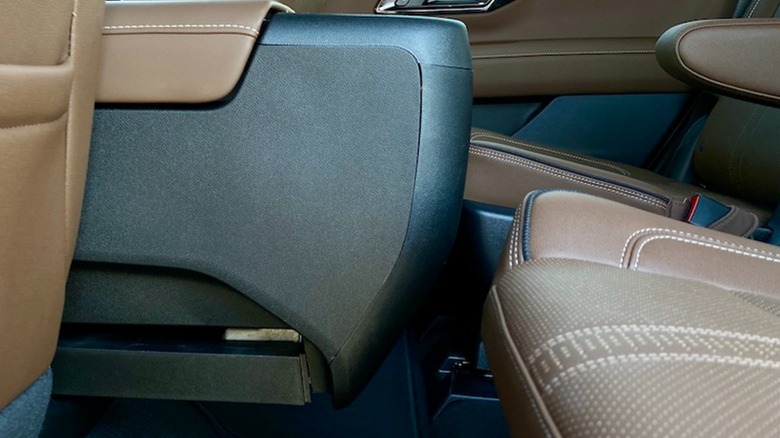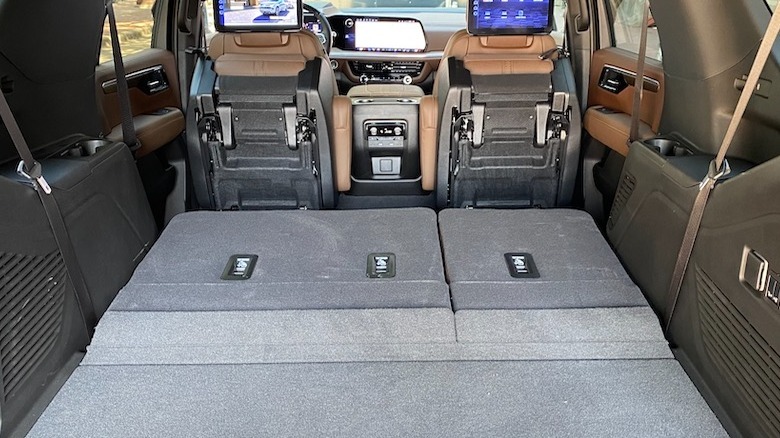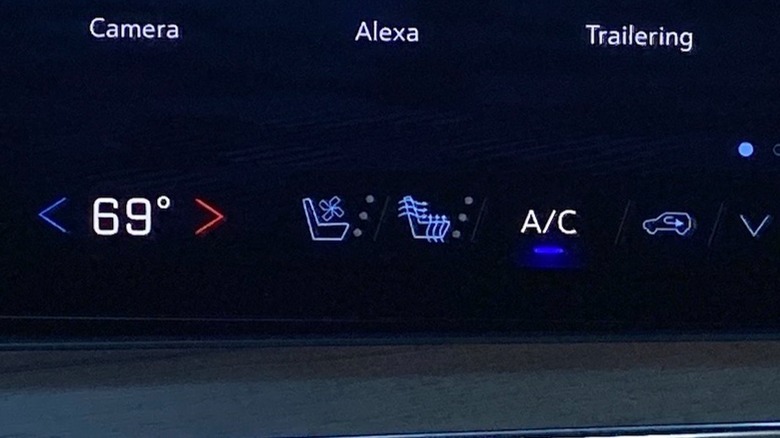The Chevrolet Tahoe and Suburban are two of the biggest SUVs you can buy today. These two family-hauling behemoths have been refreshed for 2025 with new looks, updated features, and more power via the optional diesel engine. On top of offering stout power and towing capability, these truck-based SUV siblings are also packed with features that improve the driving experience and make them more family friendly.
Sticking to the formula that’s been successful for both the Tahoe and Suburban for years, they both continue to offer cavernous interiors, lots of plush trim levels to choose from, and three rows of comfortable seating. And as you’d probably expect, there are plenty of charging ports, cupholders, and storage options for small items.
Rivals offer similar experiences but we thought it was worth exploring the interiors of the Tahoe and the Suburban, taking a closer look at their equipment levels, available features, and hidden talents. A quick note: the Tahoe gets top billing here but we cover both the Tahoe and the Suburban, using photos of both SUVs along the way; the key physical difference is the length of the cargo compartment.
High quality customizable screens
One of the biggest improvements for the refreshed 2025 Tahoe and Suburban is the massive center screen, which measures 17.7 inches diagonally and it’s standard, regardless of trim level. This same screen appears in several of Chevy’s newest products (like the Equinox EV and the Blazer EV) and it’s a welcome addition to the Tahoe’s interior. It’s also a significant size increase compared to the old 8-inch and 10.2-inch screens. More than just a larger display, the new screen has impressive graphics and quick responses to touch inputs. It’s also customizable.
The big screen itself has no shortage of icons, covering phone calls, a place to select your music, general settings, etc. But the top left of the screen features a configurable row of icons too. These can be adjusted and set by the driver depending on your favorite shortcuts, a lot like how you can organize apps on your smartphone.
The large driver display is customizable too
Beyond the massive 17.7-inch center screen, the Tahoe and Suburban come with an impressive 11-inch driver display that can be configured to fit your preferences. Want to keep your music selection showing on the center infotainment screen while navigation displays on the driver screen? No problem. Tap the steering wheel button and it will toggle between multiple screen options for the driver.
More than just a nav screen, you can also go with the typical stuff like trip meter, fuel economy, four-wheel drive settings, and a digital tachometer, as well as display options for audio and cruise control/driver aids. Just like the center screen, the driver display has crisp and easy-to-read graphics and fonts. And if all that high-res surface area isn’t enough for you, there’s an available 15-inch head-up display, too.
A rear-seat media system is available, with a pair of 12.6-inch displays for second row passengers. These can display unique content via HDMI ports and they can connect via Bluetooth to headphones for passengers in the back seat. It’s a great addition for families who go on long road trips, but the added cost ($1,995) might have you googling how much a couple of tablets might be instead.
Multiple seating configurations
With both the Tahoe and the Suburban, it’s possible to seat as many as nine people inside, at least on the base trim level. The standard seating configuration for the base LS model is a front row with two bucket seats (also known as captain’s chairs), but a bench seat is optional. The second and third row each get three-seat benches. Unfortunately, it’s only possible to fit seven passengers on the highest trim levels, as they come exclusively with second-row captain’s chairs.
On the Premier and High Country trims, the second row of seats are power-adjustable and the third row is power-folding. The power-folding third row can be folded both up and down, with the quick touch of a button in the trunk area, or up front from the driver’s overhead controls. It turns out, this functionality is extremely convenient.
If you’re loading in large gear, like skis or lumber, the rear-fold down buttons will get the job done. But, if your passengers have lots of items to load in (think multiple kids loading in from soccer practice or a crew of passengers hopping in via Uber or Lyft), you can fold the third row down (or bring it back up) without ever exiting the driver’s seat.
Lots of driver aids – standard and optional
Across the board, all Tahoe and Suburban models get a full suite of driver aids. Those include automatic forward emergency braking that’s programmed to detect pedestrians and cyclists as well as vehicles, reverse automatic braking, lane-keep assist, blind-spot monitoring, a surround-view camera, adaptive cruise control, and parking assist. Optional features like the rearview camera mirror give you a clear visual of what’s behind you, even if you’ve got passengers and luggage piled all the way to the roof.
The biggest driver aid though, is Chevy’s optional Super Cruise hands-free driving system. Lane centering, braking, accelerating when there’s an open gap ahead, and changing lanes all on its own are all part of Super Cruise. It’s available on upper trim levels of the Tahoe and Suburban, and while it won’t be included in early 2025 models (expect it later in the year) we’d recommend picking a trim with Super Cruise if you can swing it.
Multiple storage options including hidden ones

If you bring along all sorts of extra water bottles and coffee cups any time you leave the house, the Tahoe and Suburban have you covered. There are multiple options for cupholders in all three rows. All four doors offer large pockets for water bottles and space for extra items too. A big glove box and a massive center console gives you room to store items out of sight when you park. Plus, the Tahoe and Suburban have a fun party trick up their sleeve.

The center console between the driver and front passenger seats has a power-sliding feature on Premier and High Country models: It moves back to reveal a large lower area for storage. In turn, that reveals a slide-out storage drawer that’s about the size of your hand. Chevy’s been doing this kind of hidden-storage feature for a while – in the past they even featured a powered-drop-down infotainment screen on the C7 Corvette. When the console is in its rearward position, it partially blocks entry and exit to and from the third row, but it can easily be slid back into place.
An organized chaos of buttons and controls

Towing and hauling settings require special controls, knobs and buttons. So do power-folding seats and power-sliding center consoles. Stereo and climate-control operation, driver settings, power-seat controls, and headlights… they all need physical controls or touchscreen controls at the very least. Thankfully, the dashboard of the Tahoe features a relatively well-organized array of switchgear spanning from the left of the steering wheel, across the steering wheel itself, through the center console, up into the infotainment screen, and even into the overhead area.

There’s clearly a hierarchy of buttons, with commonly used features like fan speed and temperature sticking to physical controls in the center of the dash. Lesser-used items like the trailer gain, the four-wheel-drive selection, and the hill-descent control are all on the left of the steering wheel, hidden from regular sight. The touchscreen houses a few controls, like the ones for heated seats and ventilated seats, but making those selections is pretty easy with such a large and prominent center screen.
Massive trunk space with the seats folded

Seeing as how they take up a significant amount of square footage on the outside, it’s not a big surprise that the Tahoe and Suburban also offer quite a bit of interior space too. Fold the second and third row flat and the Tahoe offers 122.7 cubic feet of cargo storage. For reference, the Jeep Wagoneer offers 96.9 cubic feet with the last two rows folded, and the standard-wheelbase Ford Expedition checks in at 108.5 cubic feet.

The Suburban offers even more space. A whopping 144.5 cubic feet of storage leads the class amongst big three-row SUVs. Ford’s Expedition MAX maxes out at 123.1 cubic feet of space – barely enough to top the Tahoe and well behind the Suburban’s top figure. Aside from a few minivans like the 2025 Kia Carnival, cargo vans, and full-size pickup trucks, there aren’t too many vehicles that can compete with the Tahoe and Suburban for sheer hauling capability.
Heating and ventilation in multiple seating locations

Having a spacious interior is a prerequisite for a family vehicle like the Chevrolet Tahoe, but what’s almost as important is the comfort level of that interior. We found the 2025 Tahoe and Suburban to have impressive ride quality with optional magnetic ride control suspension to smooth out the bumps, but the seats are worth a mention, too. While you don’t get heated front seats on the base LS model, they are standard on the LT and above.

Many General Motors products that offer heated seats do so with a split heater setup – the Suburban and Tahoe are included on this list. The seat-heating function can be split up to heat either the bottom and back portion of the seat, or just the back. It’s a small difference, but it means you can use the seat heater to soothe your aching back without heating up your legs.
The RST gets perforated leather upholstery on the seats, allowing the fabric to breathe a bit more. From there, the Premier and High Country add heated second-row seats (and a heated steering wheel), as well as heated-and-ventilated front seats. These flagship trims require a pretty high cost of entry, but the comfort levels are high.
